The problem with organic food
Does the label “organic” deliver on its promise?
What does the word “organic” conjure up for you in your mind? For me, ten years ago before I began to research food, “organic” meant over-priced, blemished fruits and veggies. I certainly didn’t understand why anyone would pay extra for what I thought must be subpar produce. Of course, I had never seen an organic apple at that time – I just believed they would be full of worms, since no pesticides were used. Later, after I’d actually gone into a store that sold organic produce, and found my first organic apple to not only be blemish free, but also to be the tastiest apple I had ever had in my life, the word “organic” took on a new meaning for me. Now it meant tastier food, and it also took on the pastoral meaning of the traditional family farm – the type of mixed farm we read about in our first-grade readers.
Organic food now means food grown without chemical pesticides, herbicides, fungicides, and organic animals are fed organic feed, and are antibiotic and hormone-free, but according to Michael Pollan in his book The Omnivore’s Dilemma: A Natural History of Four Meals, originally the word “organic” meant much more than that – a communal bond that was trying to change the relationship people had with the planet in order to save it. The organic movement was born in the late 60s as a protest against the collective – anything industrial and centrist. The California hippies at the time were environmentalists that wanted to create that one-on-one connection with the earth, and to grow healthy food in a cooperative, “more gentle on the earth” way that wasn’t contaminated by the industrial, collective, “conquest” of nature” system. Living organically was a political act based upon three ideals: chemical-free farms (how food was grown), anticapitalist food co-ops (how food was distributed), and “countercuisine” or “brown food” (brown rice, brown bread etc.) which was pitted against the “white foods” created by industrial agriculture. Pollan explains how the original organic hippies believed completely that “you are what you eat”, in every sense of the word, and that one cannot separate the food you eat from how it is grown, and how it arrives at your table.
In nature, plants and animals are symbiotic. Animals poop on the plants which nourishes the soil that the plants need to grow, that the animals eat. It is a closed system that replenishes itself, and is therefore sustainable. So, mixed farms actually work quite well. But is the organic food we buy in the supermarket actually coming from these mixed farms we imagine in our heads, and does it fit the ideals of the originators of the organic movement?
I think unfortunately a lot has been lost. Over the last 40 years the growth in organic food has been tremendous, the word “organic” now representing an 11 billion dollar a year industry. With the demand for organic food being so big, suddenly organic food is being shipped thousands of miles from where it was grown, using lots of fuel for its transport. Organic farms have grown in size to handle the demand, meaning they have needed to adopt many of the industrial agriculture methods in order to process the food. Sure, the food is grown without chemicals, but heavy machinery is needed to pick, wash and package all those organic mixed leafy greens or organic baby carrots we see at the grocery store. Last week I discussed the problem of feeding cattle corn rather than grass. Organic beef is probably fed organic corn, and an organic cow will get just as sick on organic corn as a conventional cow will on conventional corn. So, we have organic factory farms which are indeed feeding their animals organic feed, but not the animals’ natural diet, putting out organic beef, milk, chicken and eggs. But now the farmer can’t use drugs to keep the animals healthy. The organic food movement has become industrialized in order to handle demand. Also, processed organic food uses the word “organic” to denote something healthy, but organic ketchup made with organic high fructose corn syrup is just as unhealthy as the conventional product.
And what do the words organic “free-range” mean when it comes to chicken and eggs? The words conjure up the idea of happy chickens running about outside in the grass, pecking out grubs – being a chicken! According to Pollan, who visited Petaluma Poultry in California which sells free-range organic roasting chickens and organic free-range eggs via the brand name “Judy’s Family Farm” through Whole Foods, 20,000 chickens live together in huge sheds. They are not in battery cages, but still live in pretty cramped quarters due to the number of chickens and the space available to them. Along the side of the shed is a grassy yard that the chickens can explore should they wish, but apparently because the door to the outdoors is shut for their first 5 weeks, they never bother going outside during the last 2 weeks of their life. But the farmer can put “free range” on the label because that option is available to the chickens for the last quarter of their life. The chickens eat the organic feed that is in trays above the ground in the sheds. So much for “free-range” chicken and eggs – seems a bit of a scam to me! They are unlikely to be getting the grubs they need to alter the nutrition of their eggs or their meat for the better, after all. I have yet to see “pasture fed” on milk, cream, yogurt, cheese or butter in my grocery store, so one must assume it is grain fed, even if it is organic.
So the organic movement, brimming with the ideals of the late 60s has turned into industrial organic, a method of farming that closely resembles that of conventional industrial agriculture. Ideals have fallen by the wayside, since the farming and distribution methods are essentially the same. Industrial organic is probably slightly better than conventional farming due to the lack of pesticides and chemical fertilizers, which would not only produce a less toxic, potentially healthier food, but would also do much more preserve the soils and protect the streams from chemical run-off. But is that good enough?? When it comes to meat, poultry, eggs and dairy, is the food healthy enough to provide us with the nutrition we need? Is this the food system we should be supporting with our hard-earned dollars?
There is a third option – a much better way, that provides healthy food and sustains the planet. Next week we’ll discuss opting out of the industrial food system. Do read Michael Pollan's fantastic book – it is well worth it.
If you want to search for other posts by title or by topic, go to www.wellnesstips.ca.
Related tips
Industrial agriculture – what’s the real cost of cheap food?
Conventional vs. Organic vs Pasture-fed meats, poultry, eggs and dairy
High Fructose Corn Syrup
Processed food is taking over our supermarkets
Food brands that contain genetically modified ingredients
Essential fats: Omega 3 to Omega 6 ratio
Food, our raw material
Gonzalez F. et al.Grain feeding and the Dissemination of Acid-Resistant Escherichia coli from Cattle Science Washington, Sept. 11, 1998, Vol. 281, Iss. 5383: p. 1666-69. (A study that shows the difference in e-coli levels between grass and grain fed cattle.)
Copyright 2008 Vreni Gurd
Permalink Comments off
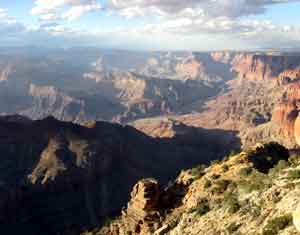 Before leaving on this backpacking trip, it would be accurate to say that I was somewhat apprehensive. It was explained to me that when a trail is described in the trail guide as “exciting” or has “considerable exposure”, that is code for “you are walking along a cliff edge, and a slip here could hurt badly.” The trails that we had committed to were considered “extremely strenuous – for experienced Grand Canyon hikers only”, which of course I was not. And the fact that my quads had still become quite sore after my training hike the week prior to leaving did not inspire much confidence that I was actually ready for the big show. Our plan was to hike north down the Tanner trail from the east end of the Park on south rim to the Colorado River, then continue north along river following the Beamer trail, hopefully to the confluence of the Little Colorado, and then retrace our steps out. Then we would drive around to the wilder north rim, and explore the Nankoweap trail, the so-called most challenging trail in the canyon, for a day or two. I spent so much energy worrying about my readiness for the trip, that I didn’t get excited about what I would experience, until we arrived at the rim.
Before leaving on this backpacking trip, it would be accurate to say that I was somewhat apprehensive. It was explained to me that when a trail is described in the trail guide as “exciting” or has “considerable exposure”, that is code for “you are walking along a cliff edge, and a slip here could hurt badly.” The trails that we had committed to were considered “extremely strenuous – for experienced Grand Canyon hikers only”, which of course I was not. And the fact that my quads had still become quite sore after my training hike the week prior to leaving did not inspire much confidence that I was actually ready for the big show. Our plan was to hike north down the Tanner trail from the east end of the Park on south rim to the Colorado River, then continue north along river following the Beamer trail, hopefully to the confluence of the Little Colorado, and then retrace our steps out. Then we would drive around to the wilder north rim, and explore the Nankoweap trail, the so-called most challenging trail in the canyon, for a day or two. I spent so much energy worrying about my readiness for the trip, that I didn’t get excited about what I would experience, until we arrived at the rim.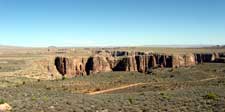 If you didn’t know it was there, you would have no idea by looking out the car window on the drive to the Grand Canyon that it actually existed at all. The land is generally flat, with small stubby trees. Occasionally one would catch a glimpse of a small gorge cut out of the plateau, but nothing to indicate the grandeur that awaited us. Even when the three of us reached the sign for the Grand Canyon National Park, there was no indication that the canyon was so near. We arrived at the south rim mid afternoon Sept. 29th, set up camp in the Desert View campground.
If you didn’t know it was there, you would have no idea by looking out the car window on the drive to the Grand Canyon that it actually existed at all. The land is generally flat, with small stubby trees. Occasionally one would catch a glimpse of a small gorge cut out of the plateau, but nothing to indicate the grandeur that awaited us. Even when the three of us reached the sign for the Grand Canyon National Park, there was no indication that the canyon was so near. We arrived at the south rim mid afternoon Sept. 29th, set up camp in the Desert View campground. 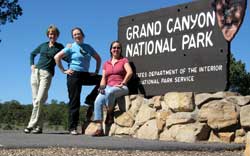 After eating lunch, we walked through the amphitheater of the campground to the rim, and I got my first breathtaking view. WOW! What struck me immediately was the size and beauty of the place. You know how people that have been to the Grand Canyon tell you that it is so big? Well it is SO BIG!!! No photograph can capture the vastness of the place – somehow it is too big for photographs. Not that that stopped us from trying.
After eating lunch, we walked through the amphitheater of the campground to the rim, and I got my first breathtaking view. WOW! What struck me immediately was the size and beauty of the place. You know how people that have been to the Grand Canyon tell you that it is so big? Well it is SO BIG!!! No photograph can capture the vastness of the place – somehow it is too big for photographs. Not that that stopped us from trying.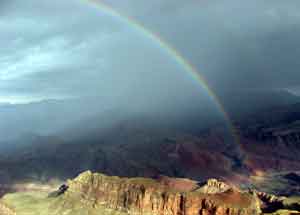 We awoke to thunderstorms the next chilly morning. We were at Lipan Point, at the Tanner trail-head by 7h30am, but thought it best to wait out the storm. I got a great picture of a rainbow over the Canyon, and by 8h30 we headed down the trail through the juniper and pinyon forest. The trail was not nearly as difficult as I thought it would be. Yes, it was steep in places, but there were also long traverses. The path was very obvious the whole way, and I found that contrary to the creek beds that I was hiking on in BC that were
We awoke to thunderstorms the next chilly morning. We were at Lipan Point, at the Tanner trail-head by 7h30am, but thought it best to wait out the storm. I got a great picture of a rainbow over the Canyon, and by 8h30 we headed down the trail through the juniper and pinyon forest. The trail was not nearly as difficult as I thought it would be. Yes, it was steep in places, but there were also long traverses. The path was very obvious the whole way, and I found that contrary to the creek beds that I was hiking on in BC that were 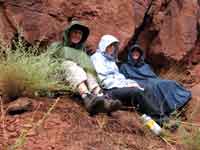 filled with slippery, roly-poly rocks, this trail was made up mostly of broken, sharp scree, so my shoes practically stuck to the trail. There were no scary cliff edges. I imagine they call this trail very strenuous because in the heat of summer there would be no break from the sun, which would wear one down. But, we were hiking in October, and the morning was cloudy. We sat out another thundershower in our rain-gear half way through the morning, but after that the weather cleared into a sunny afternoon.
filled with slippery, roly-poly rocks, this trail was made up mostly of broken, sharp scree, so my shoes practically stuck to the trail. There were no scary cliff edges. I imagine they call this trail very strenuous because in the heat of summer there would be no break from the sun, which would wear one down. But, we were hiking in October, and the morning was cloudy. We sat out another thundershower in our rain-gear half way through the morning, but after that the weather cleared into a sunny afternoon.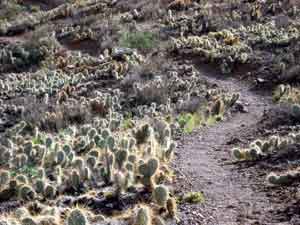 The scenery was simply beautiful. Not only the cliff faces all around us, but also the huge red boulders that dotted the landscape, the black, twisted tree trunks, the cacti, the colour of the soil, which kept changing depending upon what layer of history we were traversing. Even the rocks and small stones were crazy beautiful. You know those rock halves one can buy in gift shops where one side is a collection of crystals? Well, these kinds of rocks were lying on the path! I couldn’t believe what I was seeing. We got to the river about 5h30, set up camp, heated water to pour into our dinner bags, ate, and were in our sleeping bags by 6h30 or 6h45 because it was dark, and there wasn’t anything else to do.
The scenery was simply beautiful. Not only the cliff faces all around us, but also the huge red boulders that dotted the landscape, the black, twisted tree trunks, the cacti, the colour of the soil, which kept changing depending upon what layer of history we were traversing. Even the rocks and small stones were crazy beautiful. You know those rock halves one can buy in gift shops where one side is a collection of crystals? Well, these kinds of rocks were lying on the path! I couldn’t believe what I was seeing. We got to the river about 5h30, set up camp, heated water to pour into our dinner bags, ate, and were in our sleeping bags by 6h30 or 6h45 because it was dark, and there wasn’t anything else to do.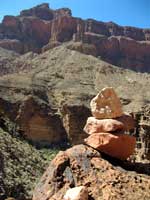 The next day we packed up camp and were on the Beamer trail by 8h30. The trail did not stay low, but rather climbed the cliffs above the river, and involved much going in and out of drainages. This trail was not as obvious, and since one in our party was French Canadian, we were looking for “inukshuks” rather than “cairns”. At about 1 o’clock, we came to a beautiful beach on the Colorado, which became our home for the next two days. It was hot, and we stripped out of our funny-looking safari outfits
The next day we packed up camp and were on the Beamer trail by 8h30. The trail did not stay low, but rather climbed the cliffs above the river, and involved much going in and out of drainages. This trail was not as obvious, and since one in our party was French Canadian, we were looking for “inukshuks” rather than “cairns”. At about 1 o’clock, we came to a beautiful beach on the Colorado, which became our home for the next two days. It was hot, and we stripped out of our funny-looking safari outfits 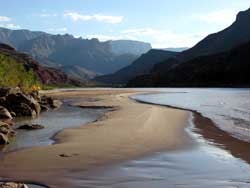 (we hiked in long pants and long-sleeve shirts to protect us from the vicious cacti, agave, and other thorny vegetation, as well as to protect us from the burning rays of the sun.) and into shorts and T-shirts, and spent a splendid afternoon wading in the ice cold water, doing laundry, and playing in the sand and mud. River rafters joined us on our beach that evening, and offered us food and wine – having already eaten, we enjoyed their wine.
(we hiked in long pants and long-sleeve shirts to protect us from the vicious cacti, agave, and other thorny vegetation, as well as to protect us from the burning rays of the sun.) and into shorts and T-shirts, and spent a splendid afternoon wading in the ice cold water, doing laundry, and playing in the sand and mud. River rafters joined us on our beach that evening, and offered us food and wine – having already eaten, we enjoyed their wine.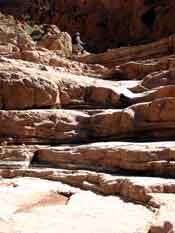 The following day our hope was to make it to the confluence of the Little Colorado. The guidebooks said the trip was long, so we set out early with light packs filled only with food and water. Once again, the trail climbed above the river 50 to 100 feet, and zigzagged in and out of drainages. The drainages looked like big red-rock amphitheatres, complete with a stage and seating, and they were usually shady. I was developing a hot-spot on one of my toes, so we had a shoe-off break so I could apply moleskin. Shoe-off breaks in the shade became a treat. Such a pleasure to be able to wiggle one’s toes around!
The following day our hope was to make it to the confluence of the Little Colorado. The guidebooks said the trip was long, so we set out early with light packs filled only with food and water. Once again, the trail climbed above the river 50 to 100 feet, and zigzagged in and out of drainages. The drainages looked like big red-rock amphitheatres, complete with a stage and seating, and they were usually shady. I was developing a hot-spot on one of my toes, so we had a shoe-off break so I could apply moleskin. Shoe-off breaks in the shade became a treat. Such a pleasure to be able to wiggle one’s toes around! We had just come out of another drainage and were rounding a butte above the river, when we saw that the trail ahead of us was right along the edge of the cliff. SCARY! And this bit seemed long! We were stopped in our tracks, not sure what to do. Going forward seemed too dangerous to be worth while, going back seemed to be a shame, so we decided to try and find another way around the butte and meet up with the trail at the next drainage. So we climbed up and over the gently sloping butte, and after picking our way down the drainage, re-found the trail. I’m not sure how long our waffling indecision and detour took, but probably at least an hour. So, we were forced to turn around by about 1 without having reached the confluence, so that we would make it back to our beach before dark. We didn’t want to be walking on the edge of cliffs in the dark!
We had just come out of another drainage and were rounding a butte above the river, when we saw that the trail ahead of us was right along the edge of the cliff. SCARY! And this bit seemed long! We were stopped in our tracks, not sure what to do. Going forward seemed too dangerous to be worth while, going back seemed to be a shame, so we decided to try and find another way around the butte and meet up with the trail at the next drainage. So we climbed up and over the gently sloping butte, and after picking our way down the drainage, re-found the trail. I’m not sure how long our waffling indecision and detour took, but probably at least an hour. So, we were forced to turn around by about 1 without having reached the confluence, so that we would make it back to our beach before dark. We didn’t want to be walking on the edge of cliffs in the dark!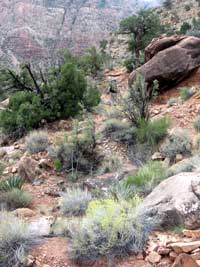 The following morning we packed up our tents, loaded our packs with filtered Colorado River water, said a regretful goodbye to our lovely beach, and headed back the way we came to Tanner beach, and then up the Tanner trail to Cardenas butte where we were to camp for the night. After dinner I was regretting that I had not packed sandals on this trip, as I was dying to get my hiking shoes off my feet. My fellow trekkers suggested that I take the insoles out of my shoes and put them in my socks! Brilliant idea! My toes were free! I loved my slippers!
The following morning we packed up our tents, loaded our packs with filtered Colorado River water, said a regretful goodbye to our lovely beach, and headed back the way we came to Tanner beach, and then up the Tanner trail to Cardenas butte where we were to camp for the night. After dinner I was regretting that I had not packed sandals on this trip, as I was dying to get my hiking shoes off my feet. My fellow trekkers suggested that I take the insoles out of my shoes and put them in my socks! Brilliant idea! My toes were free! I loved my slippers! 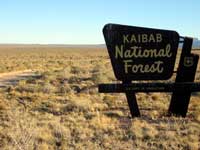 Driving to the Nankoweap trail-head on the north rim, we came across a big sign stating that we were entering the Kaibab National Forest, which I found to be particularly funny, as there was not a tree to be seen. Only open land with sage brush. Finally we got to the end of the dirt road, and we repacked our backpacks for the trek to the trail-head. They were predicting snow that night, and a low of 23 degrees, so we attached an extra fleece blanket each to our packs before heading off through what was looking more and more like that North Kaibab forest that the sign had announced. Two hours later we reached the rim, just before sunset. And yes, it was cold! We were decked out in our warmest clothes and jumping around in the dark and singing songs trying to get warm before slipping into our sleeping bags.
Driving to the Nankoweap trail-head on the north rim, we came across a big sign stating that we were entering the Kaibab National Forest, which I found to be particularly funny, as there was not a tree to be seen. Only open land with sage brush. Finally we got to the end of the dirt road, and we repacked our backpacks for the trek to the trail-head. They were predicting snow that night, and a low of 23 degrees, so we attached an extra fleece blanket each to our packs before heading off through what was looking more and more like that North Kaibab forest that the sign had announced. Two hours later we reached the rim, just before sunset. And yes, it was cold! We were decked out in our warmest clothes and jumping around in the dark and singing songs trying to get warm before slipping into our sleeping bags.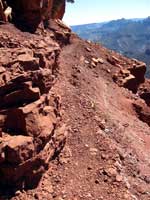 We did not wake up to snow, thankfully, but it was definitely chilly. We ate our ziploc bag breakfasts overlooking the north rim and into the beautiful Nankoweap creek basin, and did not take off too many clothes before setting out on our day hike to Marion Point. This trail was very different from the other two we had done – it was very narrow and overgrown in places, different vegetation and a lot more of it, and footing was tricky in places, but it was also breathtakingly beautiful. This was the day that I had fretted the most over before leaving, as there is the famous scary bit where one is stuck between a rock wall and a cliff edge on the way to Marion Point. Falling there would mean certain death. I had decided to take a wait and see attitude, not being sure I would be able to coax myself to do it. But when we got there, somehow it was no problem, even though the path was only about 4 inches wide at the narrowest, and right at that narrow point was a big boulder that stuck out, which meant to pass it we had to turn in to face the cliff. I certainly didn’t enjoy walking that particular 15 feet, but we all managed it twice, as we had to take the same trail back. I honestly think that had we not done the Tanner and the Beamer first, I would not have made it past that point.
We did not wake up to snow, thankfully, but it was definitely chilly. We ate our ziploc bag breakfasts overlooking the north rim and into the beautiful Nankoweap creek basin, and did not take off too many clothes before setting out on our day hike to Marion Point. This trail was very different from the other two we had done – it was very narrow and overgrown in places, different vegetation and a lot more of it, and footing was tricky in places, but it was also breathtakingly beautiful. This was the day that I had fretted the most over before leaving, as there is the famous scary bit where one is stuck between a rock wall and a cliff edge on the way to Marion Point. Falling there would mean certain death. I had decided to take a wait and see attitude, not being sure I would be able to coax myself to do it. But when we got there, somehow it was no problem, even though the path was only about 4 inches wide at the narrowest, and right at that narrow point was a big boulder that stuck out, which meant to pass it we had to turn in to face the cliff. I certainly didn’t enjoy walking that particular 15 feet, but we all managed it twice, as we had to take the same trail back. I honestly think that had we not done the Tanner and the Beamer first, I would not have made it past that point. 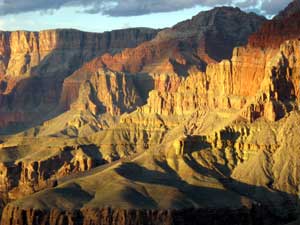 The little bit of the Nankoweap that we saw was wild and beautiful, and so unlike the Tanner of the south rim, and the Beamer along the river. Perhaps because the north rim is 1000 feet higher? Perhaps because it falls more steeply to the river? I don’t know. But I can now understand why people who hike the trails are seduced by the Grand Canyon, and yearn to go back. With each trail being so different, affording different kinds of beautiful vistas, it is hard to be satisfied with just hiking one, or two, or three. Let’s just go a little bit further to see what is around the bend …
The little bit of the Nankoweap that we saw was wild and beautiful, and so unlike the Tanner of the south rim, and the Beamer along the river. Perhaps because the north rim is 1000 feet higher? Perhaps because it falls more steeply to the river? I don’t know. But I can now understand why people who hike the trails are seduced by the Grand Canyon, and yearn to go back. With each trail being so different, affording different kinds of beautiful vistas, it is hard to be satisfied with just hiking one, or two, or three. Let’s just go a little bit further to see what is around the bend … Facebook Wellness-Tips Page
Facebook Wellness-Tips Page